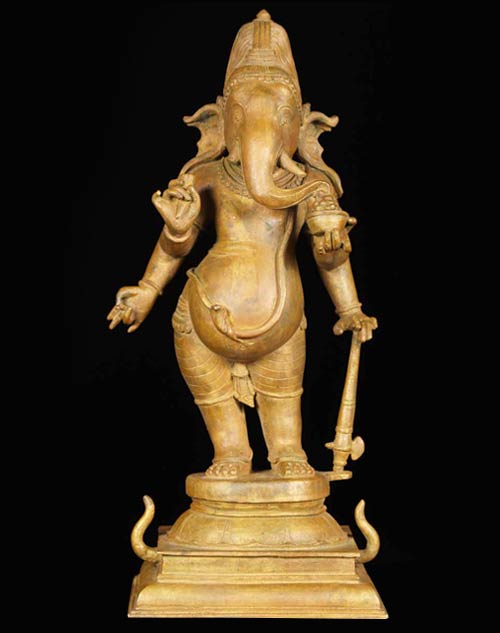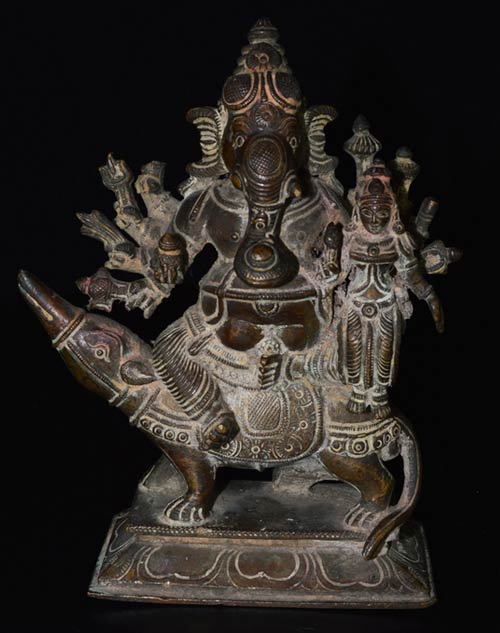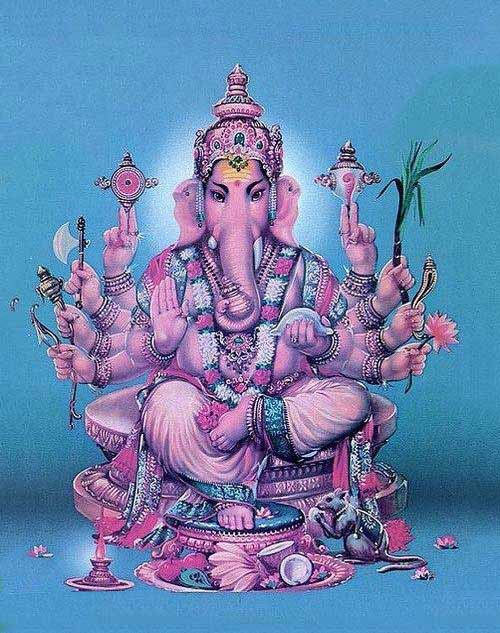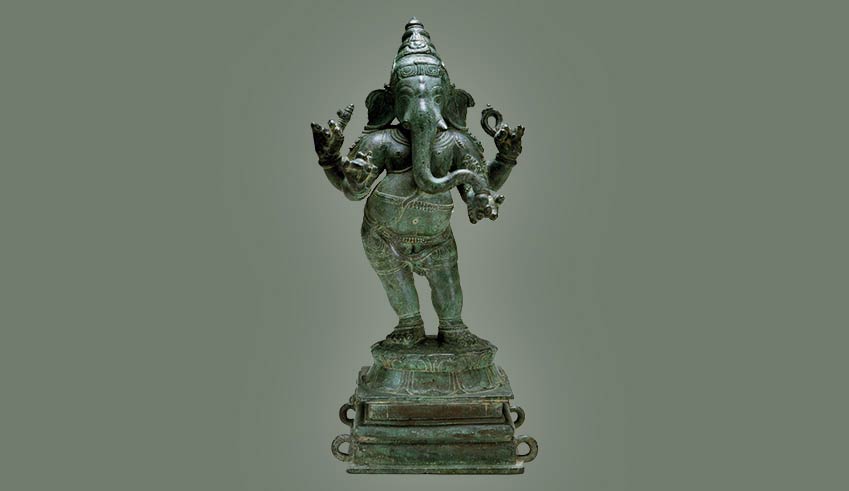
Introduction
Ganesha is one of the most popular deity among the many deities in Hindu pantheon. He is referred to by many names such as Vinayaka, Lambodara, Gajanana and so on.
Lord Ganesha finds a prominent place not only in Hindu scriptures but in Jain and Buddhist scriptures as well. While Ganesha is worshipped throughout India, he is also a popular deity in many cultures abroad in countries such as Sri Lanka, Nepal and Thailand.
Ganesha is revered both by the Shaivas, being Shiva son, and Ganapatyas, a Hindu sect that is devoted to Ganapati (Ganesha) and regards him the absolute Supreme. Ganapatya is one of the six major Hindu sects, each named after the deity that sect is dedicated to and regards supreme.
Ganesha is the elder son of Shiva and Parvati, other being Kartikeya, the god of war. Siddhi and Buddhi are two consorts of Ganesha.
He is the deity of Obstacles endowed with the power of removing or causing obstacles in any rite or ceremony and therefore must be honorably invoked before any other deity at the time of commencement. He is also the deity of intellect and wisdom and patron of letters and learning in any literary undertaking.
Lord Ganesha finds a prominent place not only in Hindu scriptures but in Jain and Buddhist scriptures as well. While Ganesha is worshipped throughout India, he is also a popular deity in many cultures abroad in countries such as Sri Lanka, Nepal and Thailand.
Ganesha is revered both by the Shaivas, being Shiva son, and Ganapatyas, a Hindu sect that is devoted to Ganapati (Ganesha) and regards him the absolute Supreme. Ganapatya is one of the six major Hindu sects, each named after the deity that sect is dedicated to and regards supreme.
Ganesha is the elder son of Shiva and Parvati, other being Kartikeya, the god of war. Siddhi and Buddhi are two consorts of Ganesha.
He is the deity of Obstacles endowed with the power of removing or causing obstacles in any rite or ceremony and therefore must be honorably invoked before any other deity at the time of commencement. He is also the deity of intellect and wisdom and patron of letters and learning in any literary undertaking.
Iconography Of Ganesha
While iconography of Ganesha varies very much according Ganesha Bronze Masterpieceto the many forms he has, the most popular depicts him with four arms, a potbelly and small legs besides an elephant head. He is mostly shown wearing a tripunda (Shaiva symbol) on his forehead and at times it is the trinetra (third eye) like Shiva.
His right tusk is shown broken as it was during a duel with Parashurama according to Padma Purana (one of the eighteen Puranas, a category of Hindu scriptures). Ganesha therefore is also called Ekdanta (one with a single tusk). There is another story in Ganesh Purana mentioning that Ganesha broke his own tusk and used it to fight Mushikaasura who eventually became the mouse to serve Ganesha as his vahana (mount).
He holds ankush (goad) in his upper right hand and paasha (noose) in upper left. His lower right hand holds his own broken tusk, which he also used to write the Mahabharata when he served as a scribe to Veda Vyasa, the author of the Mahabharata.
Ganesha holds modak (a sweet delicacy he is fond of) in his lower left hand and his trunk is shown sampling it.
His belly is round, protruding and very prominent. It is supposed to contain the universal eggs of past, present and future within. Ganesha is also therefore known as Lambodara (one with sagging belly) and Mahodara (one with huge belly).
Sri DinkamurtyVaasuki the serpent-king serves as a belt around Ganesha’s belly.
Ganesha is shown seated on a pedestal, standing or riding various vahanas,Mouse being principal among them. No vigraha (image) of Ganesha is complete without his vahana, which is shown either carrying him or sitting near his feet.
Ganesha’s vahana is called Dinka and is honourably referred to as Sri DinkaMurty. The word ‘Sri ‘ is a respectful prefix that is added before the names of celestial beings.
His right tusk is shown broken as it was during a duel with Parashurama according to Padma Purana (one of the eighteen Puranas, a category of Hindu scriptures). Ganesha therefore is also called Ekdanta (one with a single tusk). There is another story in Ganesh Purana mentioning that Ganesha broke his own tusk and used it to fight Mushikaasura who eventually became the mouse to serve Ganesha as his vahana (mount).
He holds ankush (goad) in his upper right hand and paasha (noose) in upper left. His lower right hand holds his own broken tusk, which he also used to write the Mahabharata when he served as a scribe to Veda Vyasa, the author of the Mahabharata.
Ganesha holds modak (a sweet delicacy he is fond of) in his lower left hand and his trunk is shown sampling it.
His belly is round, protruding and very prominent. It is supposed to contain the universal eggs of past, present and future within. Ganesha is also therefore known as Lambodara (one with sagging belly) and Mahodara (one with huge belly).
Sri DinkamurtyVaasuki the serpent-king serves as a belt around Ganesha’s belly.
Ganesha is shown seated on a pedestal, standing or riding various vahanas,Mouse being principal among them. No vigraha (image) of Ganesha is complete without his vahana, which is shown either carrying him or sitting near his feet.
Ganesha’s vahana is called Dinka and is honourably referred to as Sri DinkaMurty. The word ‘Sri ‘ is a respectful prefix that is added before the names of celestial beings.
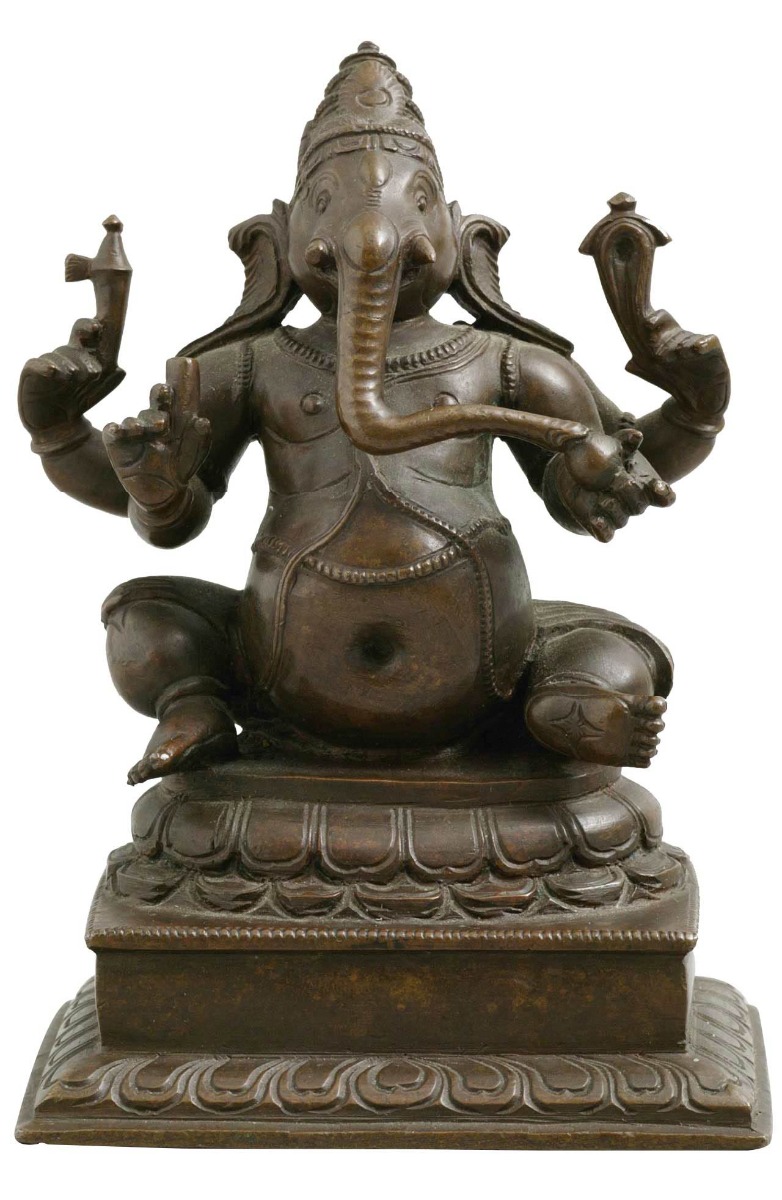
Manifestation Stories Of Ganesha From Shastras
To appreciate Hindu themes and shastras (scriptures) it is important one studies them with a given that shastra is infallible and real. When shastra is approached with such a mind-set the reader is freed of the tendency to label as mythology what he does not understand or isn’t aligned with contemporary science. Reader need also to understand that events mentioned in shastras are eternal, cyclic and simultaneous.
– That is, every deity is beyond time or in other words exists before Time manifests in a given cosmic cycle of a given universe. A deity is neither born nor dies.
– That there are unlimited universes and each is cyclic, i.e. universes manifest at the time of creation and revert into the Supreme at the time of dissolution, only to manifest again.
– That unlimited universes exist simultaneously, each at a stage controlled by its own destiny.
– That a deity may simultaneously exist in parallel universes playing out an altogether different role and set of events in each. So for example, Ganesh Purana, an authoritative text, narrates one story of how Ganesha came to lose one of his tusks whereas Padma Purana, again, an authoritative text, gives an altogether different version. Both may be considered correct as these texts are actually narrating life-events of Ganesha either from his two different manifestations in different times or in his two simultaneous manifestations in two parallel universes.
Once the above is grasped it becomes easy to understand shastra in general and also the many stories of origin of Ganesha or how he got to have an elephant head mentioned in various Puranas and Itihasas (ancient Indian history). A few are narrated here.
– That is, every deity is beyond time or in other words exists before Time manifests in a given cosmic cycle of a given universe. A deity is neither born nor dies.
– That there are unlimited universes and each is cyclic, i.e. universes manifest at the time of creation and revert into the Supreme at the time of dissolution, only to manifest again.
– That unlimited universes exist simultaneously, each at a stage controlled by its own destiny.
– That a deity may simultaneously exist in parallel universes playing out an altogether different role and set of events in each. So for example, Ganesh Purana, an authoritative text, narrates one story of how Ganesha came to lose one of his tusks whereas Padma Purana, again, an authoritative text, gives an altogether different version. Both may be considered correct as these texts are actually narrating life-events of Ganesha either from his two different manifestations in different times or in his two simultaneous manifestations in two parallel universes.
Once the above is grasped it becomes easy to understand shastra in general and also the many stories of origin of Ganesha or how he got to have an elephant head mentioned in various Puranas and Itihasas (ancient Indian history). A few are narrated here.
Shiva Purana
Once Parvati was about to take a bath when she created an image out of the discard she obtained after rubbing off the turmeric cleansable smeared on her body. She imparted it life and called him her son.
After installing him at the entrance of her abode, she gave him strict instructions not to let anyone enter.
The boy following the instructions of his mother refused entry even to Shiva, Parvati’s husband. Furious, Shiva cut off his head with his trident.
Enraged at Shiva’s act, Parvati assumed her fierce form of Adi Shakti (primeval energy) and threatened to annihilate all the three planes of existence.
Shiva pacified her by bringing the boy back to life with his head replaced with that of an elephant.
Shiva appointed him the leader of his ganas (retinue) thereby conferring the name Ganesha on him and also decreed that no auspicious ceremony may be undertaken without invoking Ganesha before other deities at the time of commencement.
After installing him at the entrance of her abode, she gave him strict instructions not to let anyone enter.
The boy following the instructions of his mother refused entry even to Shiva, Parvati’s husband. Furious, Shiva cut off his head with his trident.
Enraged at Shiva’s act, Parvati assumed her fierce form of Adi Shakti (primeval energy) and threatened to annihilate all the three planes of existence.
Shiva pacified her by bringing the boy back to life with his head replaced with that of an elephant.
Shiva appointed him the leader of his ganas (retinue) thereby conferring the name Ganesha on him and also decreed that no auspicious ceremony may be undertaken without invoking Ganesha before other deities at the time of commencement.
BrahmavaivartaPurana
According to this narrative Parvati fasted for a year to propitiate Vishnu who, pleased with her devotion, blessed her that he would be born to her in every Kalpa (a measure of Time in Hindu scriptures).
Accordingly a charming child was born to Parvati and gods were invited to the celebrations that followed. Shani (Saturn) too was among the invitees but he hesitated to look at the child. However Parvati coaxed him to take a look and the intense, fierce stare of Shani burnt the child’s head and it fell off.
Vishnu then replaced it with the head of a young elephant
Accordingly a charming child was born to Parvati and gods were invited to the celebrations that followed. Shani (Saturn) too was among the invitees but he hesitated to look at the child. However Parvati coaxed him to take a look and the intense, fierce stare of Shani burnt the child’s head and it fell off.
Vishnu then replaced it with the head of a young elephant
Uttara Ramayana
Shiva assumed the form of a tusker and Parvati that of a she-elephant on one occasion. They made love and Ganesha was born.
Other Stories Of Ganesha From Shastras
How Mouse Became Ganesha’s Vahana
There is a narrative in Ganesh Purana of how mouse became Ganesha’s vahana.
There was a vidyadhara (celestial musician) named Krauncha who worshipped Devi Tripurasundari (Supreme Divine Mother). He was transported to Devi’s realm where she granted him great boons but denied him immortality, which she said Krauncha was undeserving of yet. She then went into samadhi (a state of meditation).
Krauncha knew that the pot in one of Devi’s hands contained amritam (nectar that bestows immortality).
He assumed the form of a mouse, climbed over the pot and sipped the nectar. Seeing this Devi was offended and cursed him that he would become a mouse with mind of a rakshasa (demon), since he had acted like both. However when Krauncha regretted his act sincerely and praised Devi with heart-felt chants she was pacified and blessed him that he will meet a very auspicious destiny.
As fate would have it, Krauncha accidently stepped on sage Vaamadeva’s foot in Indra’s court once. The sage cursed him to become a mouse. When Krauncha apologized profusely and implored the sage and since he could not withdraw his own curse, he compensated by blessing him that the very gods will bow before him one day.
Due to sage Vamadeva’s curse Krauncha turned into a massive demon-mouse called Mushikasura. He was immortal having drunk amritum and he started harassing the worlds with all his unchecked might.
One day he ended up in sage Parashara’s ashrama and threatened it with destruction. Lord Ganesha was residing in Parashara’s ashram at the time and he, after indulging Mushikasura in a duel, broke his own tusk and hurled at him.
While the immortal Mushikasura could not die he was still powerless before Ganesha’s tusk, which chased him wherever he ran and caused him great suffering.
Mushikasura eventually surrendered as a transformed being to Ganesha who blessed Mushika to serve him as his eternal vahana.
There was a vidyadhara (celestial musician) named Krauncha who worshipped Devi Tripurasundari (Supreme Divine Mother). He was transported to Devi’s realm where she granted him great boons but denied him immortality, which she said Krauncha was undeserving of yet. She then went into samadhi (a state of meditation).
Krauncha knew that the pot in one of Devi’s hands contained amritam (nectar that bestows immortality).
He assumed the form of a mouse, climbed over the pot and sipped the nectar. Seeing this Devi was offended and cursed him that he would become a mouse with mind of a rakshasa (demon), since he had acted like both. However when Krauncha regretted his act sincerely and praised Devi with heart-felt chants she was pacified and blessed him that he will meet a very auspicious destiny.
As fate would have it, Krauncha accidently stepped on sage Vaamadeva’s foot in Indra’s court once. The sage cursed him to become a mouse. When Krauncha apologized profusely and implored the sage and since he could not withdraw his own curse, he compensated by blessing him that the very gods will bow before him one day.
Due to sage Vamadeva’s curse Krauncha turned into a massive demon-mouse called Mushikasura. He was immortal having drunk amritum and he started harassing the worlds with all his unchecked might.
One day he ended up in sage Parashara’s ashrama and threatened it with destruction. Lord Ganesha was residing in Parashara’s ashram at the time and he, after indulging Mushikasura in a duel, broke his own tusk and hurled at him.
While the immortal Mushikasura could not die he was still powerless before Ganesha’s tusk, which chased him wherever he ran and caused him great suffering.
Mushikasura eventually surrendered as a transformed being to Ganesha who blessed Mushika to serve him as his eternal vahana.
How Ganesha Lost One Of His Tusks
There are two versions of story behind this. One according to Padma Purana ascribes this to a duel between Ganesha and Parashurama.
Once Parashurama visited Kailas, the abode of Shiva to meet him. Ganesha stopped him at the entrance since Shiva was asleep. An altercation ensued which led to a fight among the two. Parasurama hurled his parashu (a divine axe Shiva himself granted him as boon) at Ganesha that broke one of his tusks.
Parvati was aggrieved seeing her son Ganesha hurt and Shiva, who regarded Parashurama his own son was unhappy too.
The issue ended when Parashurama repented before Ganesha, who forgave him readily.
The other story in GaneshPurana describes a duel between Ganesha and the immortal demon Mushikasura during which Ganesha himself broke off one of his tusks and hurled at the demon, which served as the final weapon that subdued Mushikasura, who eventually became Ganesha’s vahana.
Once Parashurama visited Kailas, the abode of Shiva to meet him. Ganesha stopped him at the entrance since Shiva was asleep. An altercation ensued which led to a fight among the two. Parasurama hurled his parashu (a divine axe Shiva himself granted him as boon) at Ganesha that broke one of his tusks.
Parvati was aggrieved seeing her son Ganesha hurt and Shiva, who regarded Parashurama his own son was unhappy too.
The issue ended when Parashurama repented before Ganesha, who forgave him readily.
The other story in GaneshPurana describes a duel between Ganesha and the immortal demon Mushikasura during which Ganesha himself broke off one of his tusks and hurled at the demon, which served as the final weapon that subdued Mushikasura, who eventually became Ganesha’s vahana.
Ganesha In Art
